 |
 |
 |
| |
Preclinical Profile of BI 224436, a Novel HIV-1 Non-Catalytic Site Integrase Inhibitor
|
| |
| |
Reported by Jules Levin
ICAAC Chicago 2011 Sept 17-20
Christiane Yoakim , Ma'an Amad, Murray D. Bailey, Richard Bethell, Michael Bos, Pierre Bonneau, Michael Cordingley, Rene Coulombe, Jianmin Duan, Paul Edwards, Lee Fader, Anne-Marie Faucher, Michel Garneau, Araz Jakalian, Stephen Kawai, Louie Lamorte, Steven LaPlante, Laibin Luo, Steve Mason, Marc-Andre Poupart , Nathalie Rioux, Bruno Simoneau, YoulaTsantrizos#, Myriam Witvrouw and Craig Fenwick Boehringer Ingelheim (Canada) Ltd., Research and Development
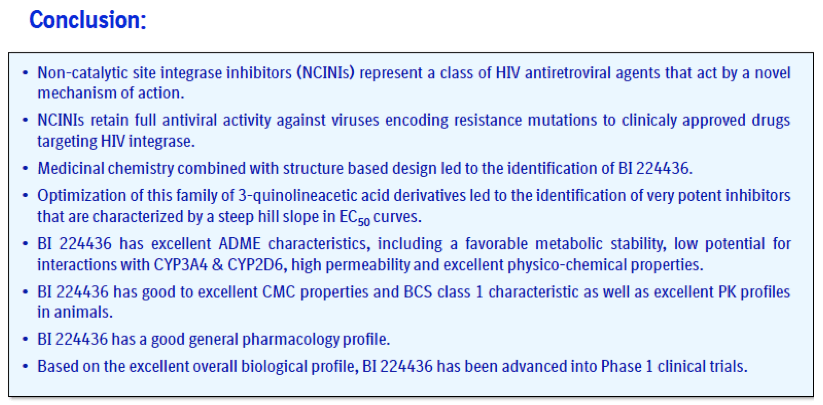
Abstract
Background: Non-catalytic site integrase inhibitors (NCINIs) represent a novel class of HIV-1 antiretroviral that bind to a conserved allosteric pocket on integrase (IN) and specifically inhibit the IN LTR DNA 3' processing activity. In contrast, marketed and late stage clinical drugs targeting IN bind at the catalytic site and are primarily integrase strand transfer inhibitors (INSTIs). Consistent with a novel mechanism of action, NCINIs have a non-overlapping resistance profile with INSTIs such as raltegravir.
Methods: Using an enzymatic IN LTR DNA 3' processing assay a 3-quinolineacetic acid derivative was identified as an interesting lead structure. A combination of medicinal chemistry and structure-guided drug design has led to the identification of BI 224436 as a candidate for pre-clinical profiling.
Results: BI 224436 has antiviral EC50 values ranging between 4 and 15 nM against different HIV-1 laboratory strains and CC50 values >90 μM in different cells, including peripheral blood mononuclear cells. BI 224436 also has a low, 2.2-fold shift in antiviral potency in the presence of 50% human serum and by virtue of a steep dose-response curve slope, BI 224436 exhibits serum-shifted EC95 values ranging between 22 and 75 nM. Drug combination studies performed in cell-based antiviral assays have shown that BI 224436 displays, at the least, an additive effect in combination with any of the marketed antiviral classes including INSTIs. BI 224436 has drug-like ADME properties including a Caco-2 cell permeability of 14 .10-6 cm/sec, solubility > 24 mg/ml in the pH range 2.0-6.8 and low cytochrome P450 inhibition. Moreover BI 224436 shows excellent PK profiles in rat (CL=0.7% QH; F= 54%), monkey (CL= 23% QH; F= 82%) and dog (CL= 8%QH; F= 81%).
Conclusion: BI 224436 is a potent HIV-1 integrase inhibitor. Based on the excellent biological and PK profile, BI 224436 has been advanced into Phase 1 clinical trials.
Introduction
It has become increasingly challenging to identify compounds within the existing classes of HIV-1 inhibitors due to cross-resistance and lack of differentiation in their profiles. Moreover new candidates should possess suitable properties for once daily dosing and inclusion in fixed dose combinations. As a result, research focus has been shifting in recent years towards the identification of new mechanisms of inhibition in order to provide novel regimen combinations for the treatment of HIV-1 infection. HIV-1 integrase (IN) has two related enzymatic activities that are essential for viral replication; the LTR DNA 3' processing reaction and the strand-transfer reaction which integrates viral DNA into the host genomic DNA (Figure 1). Marketed and late stage clinical drugs targeting IN bind at the catalytic site and are primarily IN strand-transfer inhibitors (INSTIs). Using an IN LTR DNA 3' processing assay in a high throughput format, followed by hit to lead optimization led to the identification of a 3-quinolineacetic acid series. This series generated inhibitors with high potency in antiviral assays and excellent ADMETproperties.
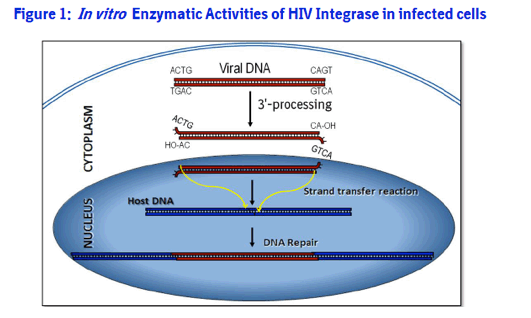
Methods
-The LTR DNA 3'- processing assay used a DNA probe consisting of two annealed oligonucleotides with a 3'-end Black Hole Quencher and a 5'-end Rhodamine Red fluorophore (Figure 2). The E. coli DNase cleavage counter screen assay was conducted using the same oligonucleotide probe.
- Apparent KD values were determined with a biochemical displacement assay using a biotinylated inhibitor probe. The probe used has an estimated KD of 0.2 μM.
-Antiviral assays: EC50 values were determined using C8166 HIV-1 Luciferase assay (WO 2007 / 131350). Cells were infected with either HXB2 or NL4-3 lab HIV strains. A standard p24 ELISA assay was also used for key compounds for comparison purposes.

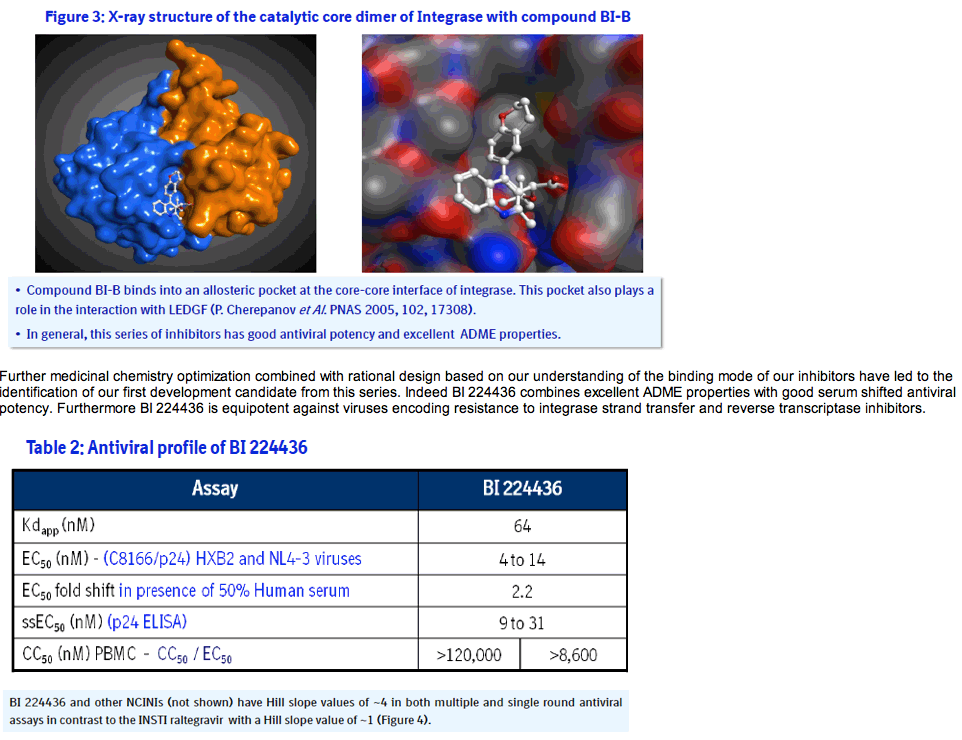
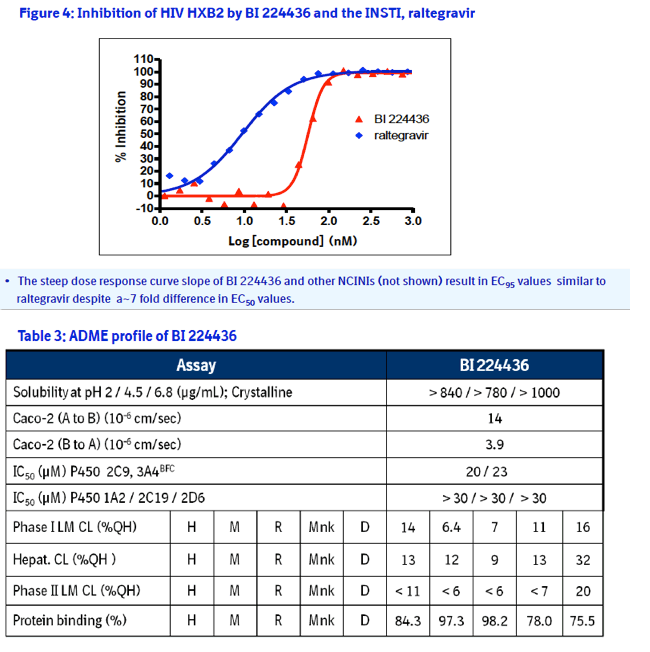
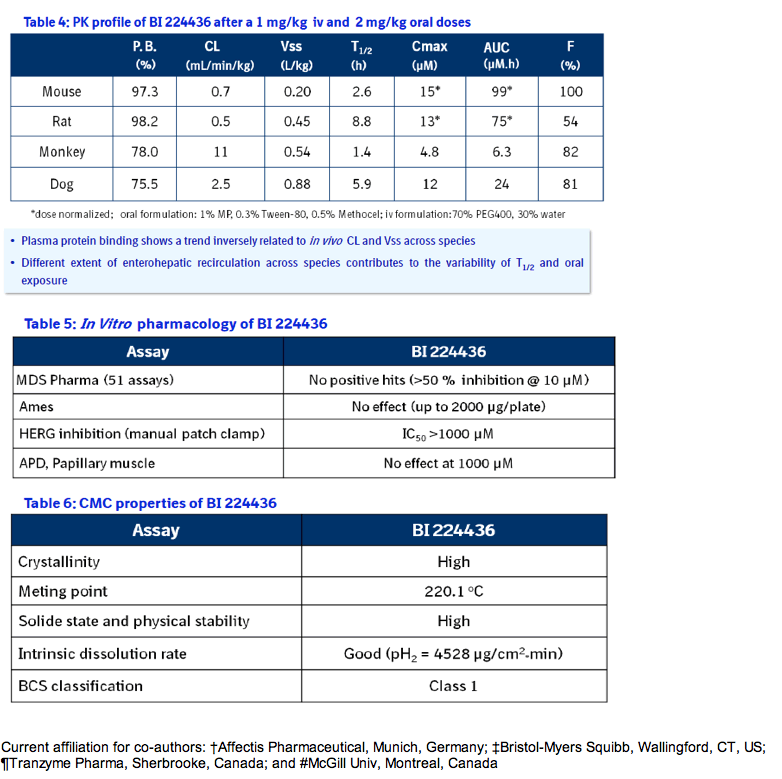
|
| |
|
 |
 |
|
|